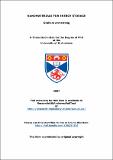Files in this item
Nanomaterials for energy storage
Item metadata
| dc.contributor.advisor | Bruce, Peter G. | |
| dc.contributor.author | Armstrong, Graham M. | |
| dc.coverage.spatial | 215 p. | en |
| dc.date.accessioned | 2007-06-21T10:42:58Z | |
| dc.date.available | 2007-06-21T10:42:58Z | |
| dc.date.issued | 2007-06-20 | |
| dc.identifier | uk.bl.ethos.551995 | |
| dc.identifier.uri | https://hdl.handle.net/10023/355 | |
| dc.description.abstract | Nanotubes (inner diameter of 8nm and outer diameter of 10nm with a length of up to several hundred nm) and nanowires (diameter 20 – 50nm and up to several μm in length) of TiO₂-B have been synthesised and characterised for the first time. These exhibit excellent properties as a host for lithium intercalation and are able to accommodate lithium up to a composition of Li₀.₉₈TiO₂-B for the nanotubes and Li₀.₈₉TiO₂-B for the nanowires. Following some irreversible capacity on the first cycle, which could be reduced to 4% for the nanowires, capacity retention for the nanowires is 99.9% and for the nanotubes is 99.5% per cycle. In both cases, the cycling occurs at ~1.6V versus lithium. The cycling performance was compared with other forms of bulk and nano-TiO₂, all of which were able to intercalate less lithium. Nanowires of VO₂-B (50 – 100nm in diameter and up to several μm in length) were synthesised by a hydrothermal reaction and characterised. By reducing the pressure inside the hydrothermal bomb, narrower VO₂-B nanowires with a diameter of 2 – 5nm and length of up to several hundred nm were created - some of the narrowest nanowires ever made by a hydrothermal reaction. These materials are isostructural with TiO₂-B and were also found to perform well in rechargeable lithium ion batteries, being able to intercalate 0.84Li for the ultra-thin nanowires and 0.57Li for the standard nanowires. The standard VO₂-B nanowires have a capacity retention of 99.8% and the ultra-thin nanowires have 98.4% per cycle after some irreversible capacity on the first cycle. This was found to improve markedly when different electrolytes were used. Macroporous Co₃O₄ (pore size 400nm with a surface area of 208m²/g) was prepared and cycled in rechargeable lithium cells with capacities of 1500mAh/g being achieved. The structure was found to break down on the first cycle and after this the material behaved in the manner of Co₃O₄ nanoparticles. Finally a new candidate for next generation rechargeable lithium batteries was examined; Li/O₂ cells. The cathode is composed of porous carbon in which Li⁺, e⁻ and O₂ meet to form Li₂O₂ on discharge. The reaction is reversible on charge. Capacities of 2800mAh/g can be achieved when 5%mole of αMnO₂ nanowires catalyst is used. Fade is high at 3.4% per cycle meaning that there is much work to do to develop these into a commercial prospect. | en |
| dc.format.extent | 2675 bytes | |
| dc.format.mimetype | application/pdf | |
| dc.language.iso | en | en |
| dc.publisher | University of St Andrews | |
| dc.subject | TiO₂-B | en |
| dc.subject | VO₂-B | en |
| dc.subject | Nanotubes | en |
| dc.subject | Nanowires | en |
| dc.subject | Lithium | en |
| dc.subject | Batteries | en |
| dc.subject | Co₃O₄ | en |
| dc.subject | Air batteries | en |
| dc.subject | Cell | en |
| dc.subject | Rechargeable | en |
| dc.title | Nanomaterials for energy storage | en |
| dc.type | Thesis | en |
| dc.type.qualificationlevel | Doctoral | en |
| dc.type.qualificationname | PhD Doctor of Philosophy | en |
| dc.publisher.institution | The University of St Andrews | en |
This item appears in the following Collection(s)
Items in the St Andrews Research Repository are protected by copyright, with all rights reserved, unless otherwise indicated.

